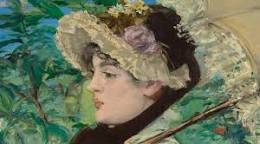The Revolutionary Artistry of Edouard Manet
Edouard Manet, a French painter born in 1832, is renowned for his groundbreaking contributions to the world of art. Considered a pivotal figure in the transition from Realism to Impressionism, Manet’s works challenged traditional artistic conventions and paved the way for modern art movements.
Early Life and Influences
Manet’s artistic journey began with a passion for painting, nurtured by his upbringing in Paris. He drew inspiration from the works of Old Masters such as Diego Velazquez and Francisco Goya, as well as contemporary painters like Gustave Courbet. These influences shaped his artistic style and set him on a path towards innovation.
Defying Convention
Manet’s bold approach to artistry often sparked controversy and criticism. His painting “Le Dejeuner sur l’herbe” (Luncheon on the Grass) caused a stir with its unconventional composition and subject matter, challenging societal norms of the time. Similarly, “Olympia,” depicting a nude woman staring directly at the viewer, shocked audiences with its directness and modernity.
A Legacy of Influence
Despite facing resistance from critics initially, Manet’s work ultimately earned recognition for its innovative techniques and artistic vision. His use of loose brushwork, bold colors, and unconventional compositions inspired future generations of artists, including the Impressionists who followed in his footsteps.
Legacy and Impact
Today, Edouard Manet’s legacy lives on as a testament to the power of artistic expression and creative freedom. His contributions to art continue to influence contemporary artists and shape the trajectory of modern art movements. Through his revolutionary spirit and visionary approach to painting, Manet remains an enduring icon in the history of art.
Exploring Edouard Manet: His Life, Art Style, Famous Works, Influence, Controversies, and Legacy
- Who was Edouard Manet?
- What style of art is Edouard Manet known for?
- What were some famous paintings by Edouard Manet?
- How did Edouard Manet influence the art world?
- What controversies surrounded Edouard Manet’s work?
- What is Edouard Manet’s legacy in the history of art?
Who was Edouard Manet?
Edouard Manet was a pioneering French painter born in 1832, known for his significant impact on the art world. Considered a key figure bridging the gap between Realism and Impressionism, Manet challenged traditional artistic norms with his innovative approach to painting. His works, such as “Le Dejeuner sur l’herbe” and “Olympia,” sparked controversy for their unconventional compositions and subject matter, pushing boundaries and redefining the artistic landscape of his time. Manet’s legacy as a visionary artist continues to resonate today, inspiring generations of artists and shaping the evolution of modern art movements.
What style of art is Edouard Manet known for?
Edouard Manet is primarily known for his pioneering contributions to the transition from Realism to Impressionism in the world of art. He is recognized for his distinctive style that challenged traditional artistic conventions of his time. Manet’s works often feature loose brushwork, bold colors, and unconventional compositions that set him apart as a revolutionary artist. His ability to capture modern life with a fresh perspective and innovative techniques solidified his reputation as a leading figure in the development of modern art movements.
What were some famous paintings by Edouard Manet?
Edouard Manet, a pioneering artist of the 19th century, is renowned for several iconic paintings that have left a lasting impact on the art world. Some of his most famous works include “Le Dejeuner sur l’herbe” (Luncheon on the Grass), a controversial piece that challenged societal norms with its unconventional composition; “Olympia,” a bold depiction of a nude woman staring directly at the viewer; and “A Bar at the Folies-Bergere,” which masterfully captured the complexities of modern urban life. These paintings showcase Manet’s innovative techniques, use of light and color, and his ability to push artistic boundaries, solidifying his legacy as a trailblazer in the realm of art.
How did Edouard Manet influence the art world?
Edouard Manet’s influence on the art world is profound and far-reaching. As a pivotal figure in the transition from Realism to Impressionism, Manet challenged traditional artistic conventions with his innovative approach to painting. His bold compositions, use of loose brushwork, and unconventional subject matter pushed boundaries and redefined artistic norms of his time. Manet’s daring spirit and commitment to creative freedom inspired future generations of artists, including the Impressionists who followed his lead. Through his revolutionary vision and groundbreaking techniques, Edouard Manet left an indelible mark on the art world, shaping the trajectory of modern art movements and continuing to inspire artists to this day.
What controversies surrounded Edouard Manet’s work?
Edouard Manet’s work was surrounded by controversies that stemmed from his bold and innovative artistic choices. One of the most notable controversies revolved around his painting “Le Dejeuner sur l’herbe” (Luncheon on the Grass), which challenged traditional artistic norms with its unconventional composition and subject matter. Critics and audiences were shocked by the juxtaposition of a nude woman among clothed men in a contemporary Parisian setting. Additionally, Manet’s painting “Olympia,” depicting a nude woman staring directly at the viewer, sparked debates about propriety and morality in art. These controversies highlighted Manet’s willingness to defy conventions and push boundaries, ultimately solidifying his reputation as a pioneering artist ahead of his time.
What is Edouard Manet’s legacy in the history of art?
Edouard Manet’s legacy in the history of art is profound and enduring. As a pioneering figure in the transition from Realism to Impressionism, Manet challenged traditional artistic conventions and paved the way for modern art movements. His bold approach to composition, use of light and color, and willingness to tackle controversial subject matter left a lasting impact on the art world. Manet’s innovative techniques and artistic vision inspired future generations of artists, influencing the development of modern art and shaping the trajectory of artistic expression. Today, his legacy serves as a testament to the power of creative freedom and the enduring influence of visionary artists in shaping the course of art history.




